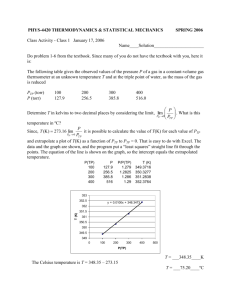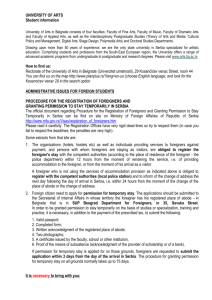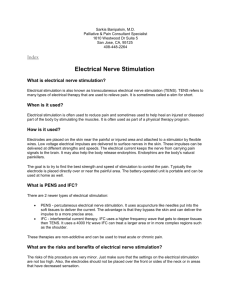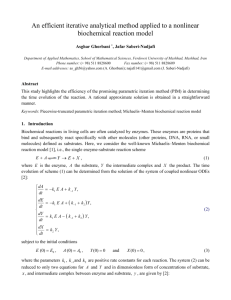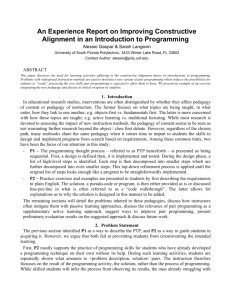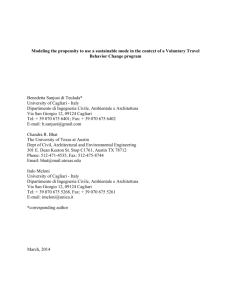The instrumentation for the analysis of effects of the descending
advertisement
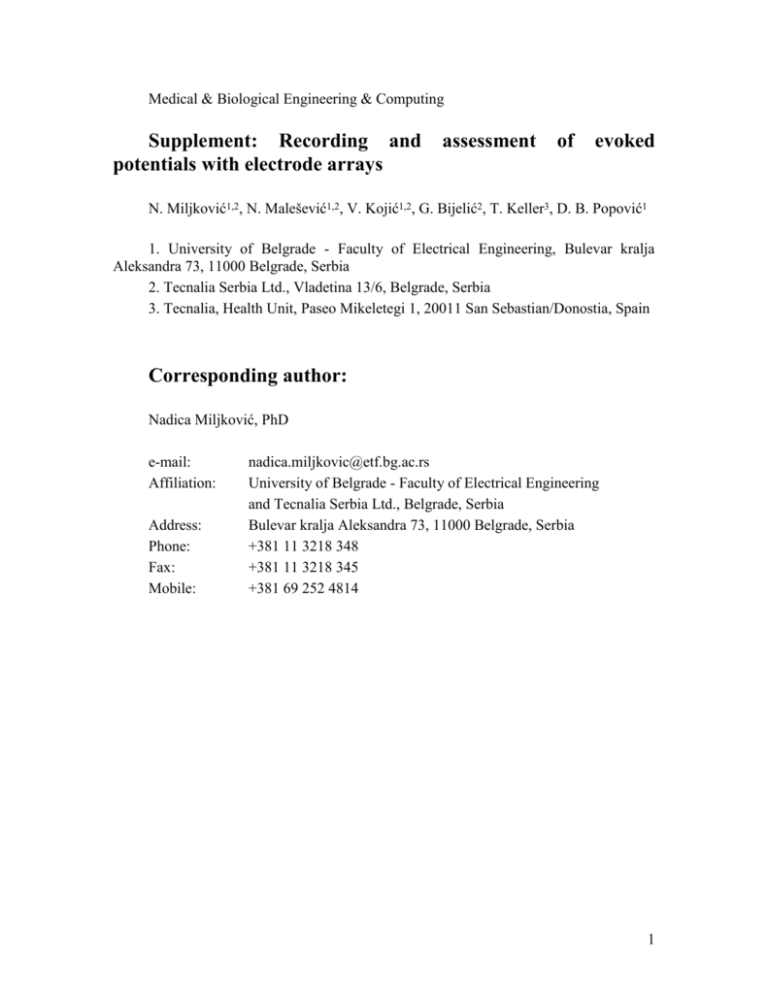
Medical & Biological Engineering & Computing Supplement: Recording and potentials with electrode arrays assessment of evoked N. Miljković1,2, N. Malešević1,2, V. Kojić1,2, G. Bijelić2, T. Keller3, D. B. Popović1 1. University of Belgrade - Faculty of Electrical Engineering, Bulevar kralja Aleksandra 73, 11000 Belgrade, Serbia 2. Tecnalia Serbia Ltd., Vladetina 13/6, Belgrade, Serbia 3. Tecnalia, Health Unit, Paseo Mikeletegi 1, 20011 San Sebastian/Donostia, Spain Corresponding author: Nadica Miljković, PhD e-mail: Affiliation: Address: Phone: Fax: Mobile: nadica.miljkovic@etf.bg.ac.rs University of Belgrade - Faculty of Electrical Engineering and Tecnalia Serbia Ltd., Belgrade, Serbia Bulevar kralja Aleksandra 73, 11000 Belgrade, Serbia +381 11 3218 348 +381 11 3218 345 +381 69 252 4814 1 TableSUP 2 Optimal stimulation pad (OSP) location is presented (a…d in transverse plain direction marked as raw, and a…d in coronal plane direction marked as column). Optimal recording pad (ORP) location is presented (1…4 in transverse plane direction marked as raw, and 1…4 in coronal plane direction marked as column). Averaged maximal PTP (max PTP), averaged ΔT, and averaged ΔTHM are given with their standard deviations (SD). For each subject and stimulation current amplitude (SCA) the corresponding maximal PTP, ΔT, RF, and SF are presented. For subjects ID=6, results from 2 sessions with array electrodes and during standard clinical recordings are presented (referred in cell as "standard"). Subject ID 1 2 3 4 5 6 session 1 6 session 2 ΔTHM (SD) [ms] ΔT [ms] 1.53 (0.74) 25.28 (0.18) 20 1.60 (0.57) 21 (SD) ORP (row, column) OSP (row, column) 2.98 (0.13) (4, 3) (d, b) 25.03 (0.07) 2.83 (0.13) (4, 3) (d, b) 1.13 (0.38) 25.10 (0.32) 3.00 (0.34) (4, 3) (d, b) 22 0.81 (0.20) 24.93 (0.10) 2.85 (0.21) (4, 3) (d, b) 23 1.06 (0.89) 25.38 (0.17) 2.55 (0.26) (4, 4) (d, a) 19 0.46 (0.38) 28.73 (1.27) 3.23 (0.77) (4, 3) (d, a) 20 0.94 (0.29) 29.23 (0.29) 3.15 (0.21) (4, 3) (d, b) 21 1.24 (0.25) 29.30 (0.47) 3.25 (0.26) (4, 3) (d, a) 22 1.32 (0.40) 29.15 (0.44) 3.35 (0.26) (4, 3) (d, a) 19 0.81 (0.12) 27.33 (1.68) 2.73 (0.15) (4, 2) (a, b) 20 1.03 (0.27) 28.56 (0.38) 2.65 (0.23) (4, 2) (a, b) 21 1.17 (0.34) 28.63 (0.20) 2.65 (0.21) (4, 2) (a, b) 22 1.36 (0.59) 28.63 (0.23) 2.63 (0.20) (4, 2) (a, b) 23 1.55 (0.32) 29.05 (0.18) 2.78 (0.17) (4, 2) (a, c) 17 0.24 (0.07) 28.63 (0.36) 2.98 (0.54) (3, 3) (d, c) 18 0.26 (0.16) 27.55 (0.98) 3.48 (0.54) (4, 4) (c, b) 19 0.30 (0.28) 29.63 (0.64) 2.75 (0.61) (4, 4) (d, b) 20 0.74 (0.64) 28.10 (1.88) 2.80 (0.39) (4, 4) (d, b) 15 16 3.00 (0.90) 3.00 (1.16) 27.33 (0.49) 28.35 (0.42) 3.08 (0.87) 2.94 (0.29) (4, 4) (4, 4) (c, d) (b, d) 17 3.59 (0.62) 24.01 (1.96) 2.79 (0.25) (4, 4) (a, c) 18 3.40 (1.02) 24.80 (2.86) 2.60 (0.12) (4, 4) (a, c) 19 3.71 (0.87) 25.60 (2.57) 2.74 (0.21) (4, 4) (a, c) 16 1.65 (1.09) 25.28 (1.33) 3.11 (0.57) (4, 4) (c, c) 17 2.38 (1.04) 23.98 (0.70) 3.10 (0.50) (4, 3) (d, c) 18 2.48 (1.22) 24.42 (0.73) 3.16 (0.40) (4, 3) (d, c) 19 2.51 (1.20) 24.23 (0.73) 3.40 (0.35) (4, 3) (c, c) 20 2.49 (1.13) 24.25 (0.50) 3.05 (0.47) (4, 3) (c, c) 21 2.53 (0.80) 23.85 (0.40) 2.99 (0.58) (4, 4) (b, c) 22 2.60 (0.98) 23.96 (0.31) 2.79 (0.28) (4, 4) (b, c) 18 2.35 (1.10) 24.75 (0.43) 3.25 (0.21) (4, 4) (b, d) 19 2.61 (1.22) 24.65 (0.69) 2.83 (0.24) (4, 4) (a, c) 20 2.80 (0.95) 24.81 (0.51) 3.21 (0.18) (4, 4) (a, c) SCA [mA] Max. [mV] 19 PTP 2 Subject ID ΔTHM (SD) [ms] ΔT [ms] 2.87 (1.15) 24.60 (0.67) 14 4.24 (1.92) 16 4.87 (2.11) SCA [mA] Max. [mV] 21 6 session 1 standard 6 session 2 standard PTP (SD) ORP (row, column) OSP (row, column) 3.33 (0.36) (4, 3) (c, c) 23.89 (0.65) 3.32 (0.27) no data no data 24.14 (0.54) 3.36 (0.41) no data no data For each subject and current amplitude during the stimulation of the optimal stimulation site and recording from the optimal recording site, we calculated the maximal PTP values, ΔT, and ΔTHM parameters, which are presented in TableSUP 1. FigSUP. 1 shows five stimulation matrices for subject with ID=5 presenting optimal stimulation pad displacement due to current intensity tuning. FigSUP. 1 Normalized stimulation matrices of PTP values of H-reflexes recorded in subject with ID = 5 when the stimulation current ranged from 15 to 19 mA (1 mA steps). The sketch of the placement of the stimulation electrode array with respect to the poplietal fossa is shown in the bottom right-hand panel 3 In FigSUP. 2, the topography matrices in subject ID=6 during two sessions in three postures. The stimulation and recording electrode arrays were placed arbitrarily, so the corresponding nerve excitability over the stimulated area cannot be reproduced. FigSUP. 2 Topography maps from three postures during 2 sessions in subject ID=6. Each map is normalized to 70% of the maximal value in the corresponding position. Averaged PTP values of H-reflexes with standard deviations are 2.60±0.98, 0.61±0.23, and 5.25±0.67 mV during session 1 (current intensity 22 mA), and 2.87±1.15, 0.78±0.31, and 5.39±1.04 during session 2 (current intensity 21 mA) in the prone, sitting, and standing positions, respectively. 4
